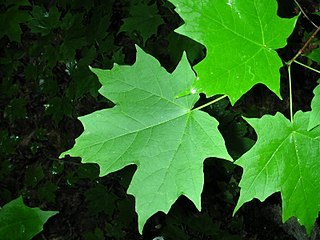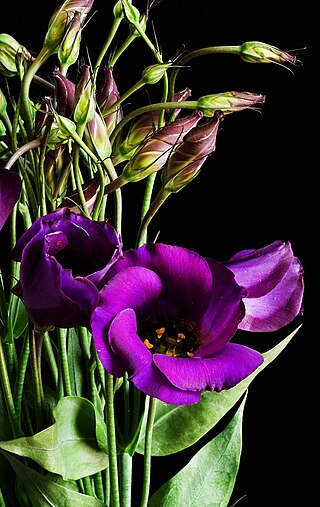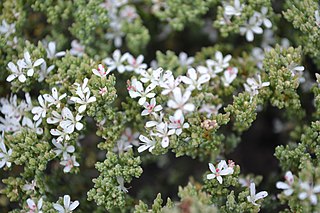
Acer saccharum, the sugar maple, is a species of flowering plant in the soapberry and lychee family Sapindaceae. It is native to the hardwood forests of eastern Canada and the eastern United States. Sugar maple is best known for being the primary source of maple syrup and for its brightly colored fall foliage. It may also be called "rock maple," "sugar tree," "sweet maple," or, particularly in reference to the wood, "hard maple," "birds-eye maple," or "curly maple," the last two being specially figured lumber.

Feijoa sellowiana also known as Acca sellowiana (O.Berg) Burret, is a species of flowering plant in the myrtle family, Myrtaceae. It is native to the highlands of southern Brazil, eastern Paraguay, Uruguay, and northern Argentina. Feijoa are also common in gardens of New Zealand. It is widely cultivated as an ornamental tree and for its fruit. Common names include feijoa, pineapple guava and guavasteen, although it is not a true guava. It is an evergreen shrub or small tree, 1–7 metres (3.3–23.0 ft) in height.

Gentianaceae is a family of flowering plants of 105 genera and about 1600 species.

Gentiana lutea, the great yellow gentian, is a species of gentian native to the mountains of central and southern Europe.

Eustoma, commonly known as lisianthus or prairie gentian, is a small genus of plants in the gentian family. They are native to warm regions of the southern United States, Mexico, Caribbean and northern South America. This genus is typically found in grasslands and in areas of disturbed ground.

Gentiana andrewsii, the bottle gentian, closed gentian, or closed bottle gentian, is an herbaceous species of flowering plant in the gentian family Gentianaceae. Gentiana andrewsii is native to northeastern North America, from the Dakotas to the East Coast and through eastern Canada.
Coastal strand is a plant community of flowering plants that form along the shore in loose sand just above the high tide line.

Eustoma russellianum is a species of flowering plant in the gentian family. One of its previous binomial names was Eustoma grandiflorum. Common names include showy prairie gentian, prairie gentian, Texas bluebells, Texas bluebell, bluebell, and Lisianthus.

Mesembryanthemum crystallinum is a species of annual/perennial, succulent flowering plant in the "mesemb" genus of the Aizoaceae family.

Aloe maculata, the soap aloe or zebra aloe, is a Southern African species of aloe. Local people in South Africa know it informally as the Bontaalwyn in Afrikaans, or lekhala in the Sesotho language.

Heliotropium curassavicum, commonly called salt heliotrope, a species of flowering plant in the borage family (Boraginaceae). It is native to much of the Americas, from Canada to Argentina, including the West Indies and Hawaii. It can be found as an introduced, and sometimes invasive, species in Africa, Asia, Australia, and Europe. It thrives in salty soils, such as beach sand, alkali flats, and salt marshes. It is often found in disturbed coastal sites.
The North America Prairies is a large grassland floristic province within the North American Atlantic Region, a floristic region within the Holarctic Kingdom. It lies between the Appalachian Province and the Rocky Mountains and includes the prairies of the Great Plains. It is bounded by the Canadian coniferous forests on the north and the arid semideserts to the southwest. The province itself is occupied by temperate grasslands, savannas, and shrublands. Endemism is rather limited in this province, and its boundaries are vague. During the Pleistocene much of the province was glaciated.

Solidago sempervirens, the seaside goldenrod or salt-marsh goldenrod, is a plant species in the genus Solidago of the family Asteraceae. It is native to eastern North America and parts of the Caribbean. It is an introduced species in the Great Lakes region. Similar plants found in the Azores are thought have evolved from a natural introduction of this species.

Canavalia rosea is a species of flowering plant of the genus Canavalia in the pea family of Fabaceae, it has a pantropical and subtropical distribution in upper beaches, cliffs, and dunes. Common names include beach bean, bay bean, sea bean, greater sea bean, seaside jack-bean, coastal jack-bean, and MacKenzie bean.

Centaurium exaltatum is a species of flowering plant in the gentian family known by the common names desert centaury and tall centaury. It is native to much of western North America from British Columbia to Arizona to Nebraska, where it grows in moist areas, generally with alkaline soils. This is an annual herb which is variable in appearance, especially in different habitat types. It grows up to about 35 centimeters in height, its slender stem with widely spaced pairs of oppositely arranged, pointed leaves 1 to 3 centimeters long. The inflorescence is an open array of flowers, each on a pedicel which may be several centimeters in length. The flower has generally four or five white or pink lobes, each somewhat rolled to appear narrow in shape.

Frankenia is the only genus in the Frankeniaceae family of flowering plants. Other genera have been recognized within the family, such as Anthobryum, Hypericopsis and Niederleinia, but molecular phylogenetic studies have consistently shown that they all belong inside Frankenia. Frankenia comprises about 70–80 species of shrubs, subshrubs and herbaceous plants, adapted to saline and dry environments throughout temperate and subtropical regions. A few species are in cultivation as ornamental plants.

Centaurium pulchellum is a species of flowering plant in the gentian family known by the common name lesser centaury, or slender centaury. It differs from Centaurium erythraea by lacking basal rosette of leaves and by having a developed peduncle below the flowers. It is often much smaller, less than ten centimetres. It is native to the southern temperate parts of Europe.

Delphinium exaltatum, known by the common name tall larkspur, is a species of flowering plant in the genus Delphinium, part of the buttercup family. Other Delphinium species are also commonly known as tall larkspur, such as Delphinium barbeyi. D. exaltatum is native to the central and eastern United States, where it can be found in Kentucky, Maine, Ohio, Pennsylvania, Maryland, West Virginia, Virginia, North Carolina, Alabama, Tennessee, and Missouri.
Allium exaltatum is a species of flowering plant in the onion genus, Allium. It is a bulbous geophyte endemic to Cyprus.
















